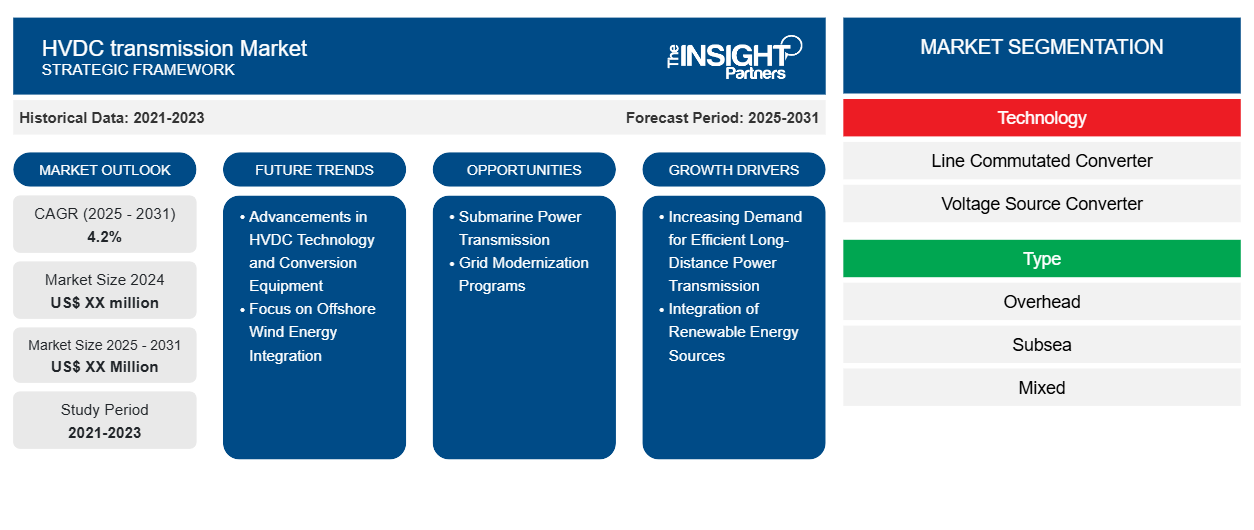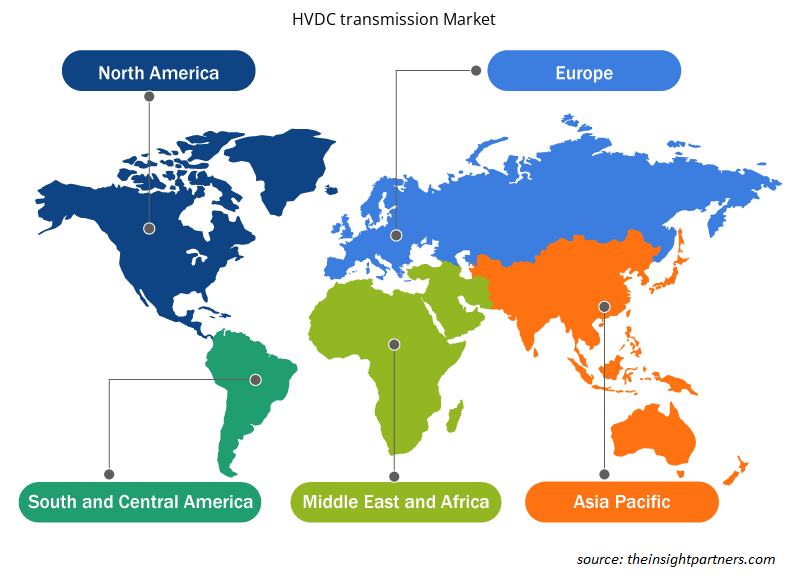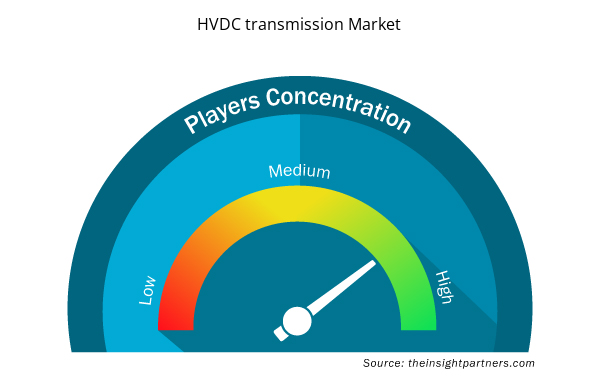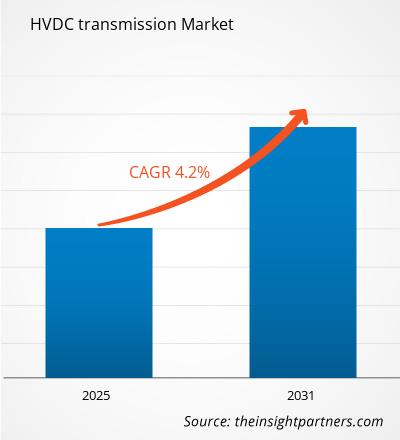Se espera que el mercado de transmisión HVDC registre una CAGR del 4,2 % entre 2025 y 2031, con un tamaño de mercado que se expandirá de US$ XX millones en 2024 a US$ XX millones en 2031.
El informe está segmentado por tecnología [(Convertidor de línea conmutada (LCC), Convertidor de fuente de voltaje (VSC)], tipo (aéreo, submarino, mixto, subterráneo). El análisis global se desglosa aún más a nivel regional y por países principales. El informe ofrece el valor en USD para el análisis y los segmentos anteriores.
Propósito del Informe
El informe "Mercado de Transmisión HVDC" de The Insight Partners busca describir el panorama actual y el crecimiento futuro, los principales factores impulsores, los desafíos y las oportunidades. Esto proporcionará información a diversos actores del sector, como:
- Proveedores/Fabricantes de Tecnología: Para comprender la dinámica cambiante del mercado y conocer las oportunidades potenciales de crecimiento, lo que les permitirá tomar decisiones estratégicas informadas.
- Inversores: Realizar un análisis exhaustivo de tendencias respecto a la tasa de crecimiento del mercado, las proyecciones financieras del mercado y las oportunidades que existen en toda la cadena de valor.
- Organismos reguladores: Regular las políticas y las actividades policiales en el mercado con el objetivo de minimizar el abuso, preservar la confianza de los inversores y defender la integridad y estabilidad del mercado.
Segmentación del mercado de transmisión HVDC
Tecnología
- Convertidor de línea conmutada
- Convertidor de fuente de voltaje
Tipo
- Arriba
- Submarino
- Mezclado
- Subterráneo
Personalice este informe según sus necesidades
Obtendrá personalización en cualquier informe, sin cargo, incluidas partes de este informe o análisis a nivel de país, paquete de datos de Excel, así como también grandes ofertas y descuentos para empresas emergentes y universidades.
Mercado de transmisión HVDC: Perspectivas estratégicas

- Obtenga las principales tendencias clave del mercado de este informe.Esta muestra GRATUITA incluirá análisis de datos, desde tendencias del mercado hasta estimaciones y pronósticos.
Factores que impulsan el crecimiento del mercado de transmisión HVDC
- Creciente demanda de transmisión eficiente de energía a larga distancia: Uno de los principales impulsores del mercado de transmisión de corriente continua de alto voltaje (HVDC) es la creciente necesidad de transmisión eficiente de energía a larga distancia. Los sistemas HVDC son particularmente eficaces para transmitir electricidad a largas distancias con menores pérdidas de energía en comparación con los sistemas tradicionales de corriente alterna (CA). A medida que los países continúan expandiendo sus redes energéticas para incorporar fuentes de energía renovables, como la eólica y la solar, la transmisión HVDC ofrece una solución óptima para conectar plantas de generación remotas con centros urbanos, impulsando así la demanda de esta tecnología.
- Integración de fuentes de energía renovables: El auge de la generación de energía renovable, en particular los parques eólicos marinos, la energía solar y la hidroeléctrica, está impulsando la adopción de sistemas de transmisión HVDC. La tecnología HVDC es ideal para integrar proyectos de energía renovable a gran escala en la red eléctrica gracias a su capacidad para gestionar altos niveles de potencia de forma eficiente a largas distancias. Además, los sistemas HVDC ofrecen un mejor control del flujo de energía y pueden ayudar a estabilizar la red al integrar fuentes de energía renovables intermitentes. Esto es especialmente relevante en regiones como Europa y Asia, donde se están realizando importantes inversiones en infraestructura de energía renovable, lo que aumenta la demanda de sistemas HVDC.hydropower, is driving the adoption of HVDC transmission systems. HVDC technology is ideal for integrating large-scale renewable energy projects into the grid due to its ability to handle high power levels efficiently over long distances. Moreover, HVDC systems offer better control over the flow of power and can help stabilize the grid when integrating intermittent renewable energy sources. This is particularly relevant in regions like Europe and Asia, where significant investments in renewable energy infrastructure are underway, thereby increasing the demand for HVDC systems.
Tendencias futuras del mercado de transmisión HVDC
- Avances en la tecnología HVDC y equipos de conversión: Existe una tendencia creciente hacia el avance de la tecnología de transmisión HVDC, en particular en el desarrollo de estaciones convertidoras más eficientes y tecnologías de semiconductores mejoradas. El uso de electrónica de potencia de alta eficiencia, como semiconductores de carburo de silicio (SiC) y nitruro de galio (GaN), está mejorando el rendimiento de los sistemas HVDC, haciéndolos más rentables y capaces de gestionar mayores capacidades. Además, las innovaciones en convertidores de fuente de tensión (VSC-HVDC) están permitiendo sistemas HVDC más flexibles, fiables y controlables, especialmente en aplicaciones que involucran la integración de energías renovables y centrales eléctricas marinas.
- Enfoque en la integración de la energía eólica marina: Otra tendencia clave es el creciente enfoque en el uso de sistemas HVDC para la integración de la energía eólica marina. Los parques eólicos marinos, ubicados lejos de la costa, requieren sistemas de transmisión eficientes y fiables para suministrar la energía generada a tierra firme. La transmisión HVDC es idónea para estas aplicaciones, ya que permite transmitir eficientemente grandes cantidades de energía a largas distancias con mínimas pérdidas, y es ideal para instalaciones de cables submarinos. A medida que los países, especialmente en Europa y Asia, incrementan sus inversiones en energía eólica marina, la tecnología HVDC se está convirtiendo en un factor crucial para la generación y transmisión de energía eólica marina a gran escala.
Oportunidades del mercado de transmisión HVDC
- Transmisión de energía submarina: La expansión de la industria de la energía eólica marina genera oportunidades para los cables submarinos de alta tensión (HVDC). La demanda de sistemas sofisticados de transmisión submarina de HVDC se debe a la necesidad de transferir energía desde instalaciones marinas a las redes terrestres, así como al crecimiento de las conexiones eléctricas intercontinentales.
- Programas de Modernización de la Red: Los programas generalizados de modernización de la red ofrecen oportunidades para instalar sistemas HVDC. Los sistemas HVDC ofrecen beneficios como el control del flujo de energía, la reducción de pérdidas y la mejora de la estabilidad general del sistema a medida que los países modernizan la infraestructura obsoleta y mejoran la confiabilidad de la red.
Perspectivas regionales del mercado de transmisión HVDC
Los analistas de Insight Partners han explicado detalladamente las tendencias y los factores regionales que influyen en el mercado de transmisión HVDC durante el período de pronóstico. Esta sección también analiza los segmentos y la geografía del mercado de transmisión HVDC en Norteamérica, Europa, Asia Pacífico, Oriente Medio y África, y Sudamérica y Centroamérica.HVDC transmission Market throughout the forecast period have been thoroughly explained by the analysts at Insight Partners. This section also discusses HVDC transmission Market segments and geography across North America, Europe, Asia Pacific, Middle East and Africa, and South and Central America.

- Obtenga los datos regionales específicos para el mercado de transmisión HVDC
Alcance del informe de mercado de transmisión HVDC
| Atributo del informe | Detalles |
|---|---|
| Tamaño del mercado en 2024 | US$ XX millones |
| Tamaño del mercado en 2031 | US$ XX millones |
| CAGR global (2025-2031) | 4,2% |
| Datos históricos | 2021-2023 |
| Período de pronóstico | 2025-2031 |
| Segmentos cubiertos | Por tecnología
|
| Regiones y países cubiertos | América del norte
|
| Líderes del mercado y perfiles de empresas clave |
|
Densidad de actores del mercado de transmisión HVDC: comprensión de su impacto en la dinámica empresarial
El mercado de transmisión HVDC está creciendo rápidamente, impulsado por la creciente demanda de los usuarios finales debido a factores como la evolución de las preferencias de los consumidores, los avances tecnológicos y un mayor conocimiento de los beneficios del producto. A medida que aumenta la demanda, las empresas amplían su oferta, innovan para satisfacer las necesidades de los consumidores y aprovechan las tendencias emergentes, lo que impulsa aún más el crecimiento del mercado.
La densidad de actores del mercado se refiere a la distribución de empresas o compañías que operan en un mercado o sector en particular. Indica cuántos competidores (actores del mercado) hay en un mercado determinado en relación con su tamaño o valor total.
Las principales empresas que operan en el mercado de transmisión HVDC son:
- TEJIDO
- C-EPRI Ingeniería de Energía Eléctrica Co., Ltd.
- GENERAL ELECTRIC
- Hitachi, Ltd
- Corporación Mitsubishi Electric
Descargo de responsabilidad : Las empresas enumeradas anteriormente no están clasificadas en ningún orden particular.

- Obtenga una descripción general de los principales actores clave del mercado de transmisión HVDC
Puntos clave de venta
- Cobertura integral: el informe cubre de manera integral el análisis de productos, servicios, tipos y usuarios finales del mercado de transmisión HVDC, proporcionando un panorama holístico.
- Análisis de expertos: el informe se compila con base en el conocimiento profundo de expertos y analistas de la industria.
- Información actualizada: El informe asegura relevancia comercial debido a su cobertura de información reciente y tendencias de datos.
- Opciones de personalización: este informe se puede personalizar para satisfacer los requisitos específicos del cliente y adaptarse adecuadamente a las estrategias comerciales.
Por lo tanto, el informe de investigación sobre el mercado de transmisión HVDC puede ayudar a descifrar y comprender el panorama de la industria y sus perspectivas de crecimiento. Si bien existen algunas preocupaciones válidas, las ventajas generales de este informe tienden a superar las desventajas.
- Análisis histórico (2 años), año base, pronóstico (7 años) con CAGR
- Análisis PEST y FODA
- Tamaño del mercado Valor/volumen: global, regional, nacional
- Industria y panorama competitivo
- Conjunto de datos de Excel


- Smart Grid Sensors Market
- Dropshipping Market
- Occupational Health Market
- Adaptive Traffic Control System Market
- Artificial Turf Market
- Vision Guided Robotics Software Market
- Truck Refrigeration Market
- Space Situational Awareness (SSA) Market
- Micro-Surgical Robot Market
- Transdermal Drug Delivery System Market

Report Coverage
Revenue forecast, Company Analysis, Industry landscape, Growth factors, and Trends

Segment Covered
This text is related
to segments covered.

Regional Scope
North America, Europe, Asia Pacific, Middle East & Africa, South & Central America

Country Scope
This text is related
to country scope.
Preguntas frecuentes
Some of the customization options available based on the request are an additional 3-5 company profiles and country-specific analysis of 3-5 countries of your choice. Customizations are to be requested/discussed before making final order confirmation# as our team would review the same and check the feasibility
The report can be delivered in PDF/PPT format; we can also share excel dataset based on the request
Voltage Source Converter (VSC) technology adoption to play a significant role in the global HVDC transmission market in the coming years
Renewable energy integration and cross-broder power trading are the major factors driving the HVDC transmission market
The HVDC Transmission Market is estimated to witness a CAGR of 4.2% from 2023 to 2031
Trends and growth analysis reports related to Electronics and Semiconductor : READ MORE..
1.ABB
2.C-EPRI Electric Power Engineering Co., Ltd
3.GENERAL ELECTRIC
4.Hitachi, Ltd
5.Mitsubishi Electric Corporation
6.NEXANS
7.NR Electric Co., Ltd
8.PSC Group, LL
9.Siemens
10.TransGrid Solutions
The Insight Partners performs research in 4 major stages: Data Collection & Secondary Research, Primary Research, Data Analysis and Data Triangulation & Final Review.
- Data Collection and Secondary Research:
As a market research and consulting firm operating from a decade, we have published and advised several client across the globe. First step for any study will start with an assessment of currently available data and insights from existing reports. Further, historical and current market information is collected from Investor Presentations, Annual Reports, SEC Filings, etc., and other information related to company’s performance and market positioning are gathered from Paid Databases (Factiva, Hoovers, and Reuters) and various other publications available in public domain.
Several associations trade associates, technical forums, institutes, societies and organization are accessed to gain technical as well as market related insights through their publications such as research papers, blogs and press releases related to the studies are referred to get cues about the market. Further, white papers, journals, magazines, and other news articles published in last 3 years are scrutinized and analyzed to understand the current market trends.
- Primary Research:
The primarily interview analysis comprise of data obtained from industry participants interview and answers to survey questions gathered by in-house primary team.
For primary research, interviews are conducted with industry experts/CEOs/Marketing Managers/VPs/Subject Matter Experts from both demand and supply side to get a 360-degree view of the market. The primary team conducts several interviews based on the complexity of the markets to understand the various market trends and dynamics which makes research more credible and precise.
A typical research interview fulfils the following functions:
- Provides first-hand information on the market size, market trends, growth trends, competitive landscape, and outlook
- Validates and strengthens in-house secondary research findings
- Develops the analysis team’s expertise and market understanding
Primary research involves email interactions and telephone interviews for each market, category, segment, and sub-segment across geographies. The participants who typically take part in such a process include, but are not limited to:
- Industry participants: VPs, business development managers, market intelligence managers and national sales managers
- Outside experts: Valuation experts, research analysts and key opinion leaders specializing in the electronics and semiconductor industry.
Below is the breakup of our primary respondents by company, designation, and region:

Once we receive the confirmation from primary research sources or primary respondents, we finalize the base year market estimation and forecast the data as per the macroeconomic and microeconomic factors assessed during data collection.
- Data Analysis:
Once data is validated through both secondary as well as primary respondents, we finalize the market estimations by hypothesis formulation and factor analysis at regional and country level.
- Macro-Economic Factor Analysis:
We analyse macroeconomic indicators such the gross domestic product (GDP), increase in the demand for goods and services across industries, technological advancement, regional economic growth, governmental policies, the influence of COVID-19, PEST analysis, and other aspects. This analysis aids in setting benchmarks for various nations/regions and approximating market splits. Additionally, the general trend of the aforementioned components aid in determining the market's development possibilities.
- Country Level Data:
Various factors that are especially aligned to the country are taken into account to determine the market size for a certain area and country, including the presence of vendors, such as headquarters and offices, the country's GDP, demand patterns, and industry growth. To comprehend the market dynamics for the nation, a number of growth variables, inhibitors, application areas, and current market trends are researched. The aforementioned elements aid in determining the country's overall market's growth potential.
- Company Profile:
The “Table of Contents” is formulated by listing and analyzing more than 25 - 30 companies operating in the market ecosystem across geographies. However, we profile only 10 companies as a standard practice in our syndicate reports. These 10 companies comprise leading, emerging, and regional players. Nonetheless, our analysis is not restricted to the 10 listed companies, we also analyze other companies present in the market to develop a holistic view and understand the prevailing trends. The “Company Profiles” section in the report covers key facts, business description, products & services, financial information, SWOT analysis, and key developments. The financial information presented is extracted from the annual reports and official documents of the publicly listed companies. Upon collecting the information for the sections of respective companies, we verify them via various primary sources and then compile the data in respective company profiles. The company level information helps us in deriving the base number as well as in forecasting the market size.
- Developing Base Number:
Aggregation of sales statistics (2020-2022) and macro-economic factor, and other secondary and primary research insights are utilized to arrive at base number and related market shares for 2022. The data gaps are identified in this step and relevant market data is analyzed, collected from paid primary interviews or databases. On finalizing the base year market size, forecasts are developed on the basis of macro-economic, industry and market growth factors and company level analysis.
- Data Triangulation and Final Review:
The market findings and base year market size calculations are validated from supply as well as demand side. Demand side validations are based on macro-economic factor analysis and benchmarks for respective regions and countries. In case of supply side validations, revenues of major companies are estimated (in case not available) based on industry benchmark, approximate number of employees, product portfolio, and primary interviews revenues are gathered. Further revenue from target product/service segment is assessed to avoid overshooting of market statistics. In case of heavy deviations between supply and demand side values, all thes steps are repeated to achieve synchronization.
We follow an iterative model, wherein we share our research findings with Subject Matter Experts (SME’s) and Key Opinion Leaders (KOLs) until consensus view of the market is not formulated – this model negates any drastic deviation in the opinions of experts. Only validated and universally acceptable research findings are quoted in our reports.
We have important check points that we use to validate our research findings – which we call – data triangulation, where we validate the information, we generate from secondary sources with primary interviews and then we re-validate with our internal data bases and Subject matter experts. This comprehensive model enables us to deliver high quality, reliable data in shortest possible time.

 Obtenga una muestra gratuita de este informe
Obtenga una muestra gratuita de este informe